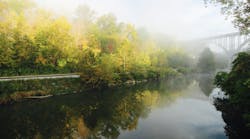City in Maryland Introduces Bill Updating Data Collection for Storm Water Regulations
Annapolis, Maryland Senator Sarah Elfreth introduced a bill that calls for updating the data used to inform storm water regulations in Maryland.
This would update every five years.
According to Elfreth, climate change and more severe rainstorms are threatening the progress Maryland has made to clean up the Chesapeake Bay.
Elfreth is also concerned about infrastructure standards not keeping up with climate change, reported the Capital Gazette. As a result, the data the Maryland Department of Environment (MDE) is using to inform its storm water standards is old and needs to be updated.
Builders must adhere to storm water management regulations to reduce pollution. This includes storing the rain from a 1 year storm and this usually means building a tank or detention pond, according to the Maryland Stormwater Manual. In Anne Arundel County, a 1 year storm is 2.7 inches of rain in 24 hours.
According to the Capital Gazette, this storm has already happened at least twice in 2020. 2.74 inches of rain fell on Nov. 30 at Baltimore-Washington International Thurgood Marshall Airport and more than 3.5 inches of rain fell at BWI on Aug. 12.
The department has several efforts underway to update the current design rainfall estimates so that they reflect recent rainfall patterns, according to MDE spokesperson Jay Apperson, reported the Capital Gazette. The department hired a contractor to predict future rainfall estimates for various climate change scenarios.
“Recognizing the need to update this data, the department is working in coordination with the Maryland Department of Transportation toward a regional Atlas 14 update. This regional update will require pooling funds with North Carolina, Virginia and Delaware,” said Tyler Abbott, Director of the Office of Legislative and Intergovernmental Relations. “If funding is secured by May of 2021, then NOAA could complete the technical analysis in 2 to 3 years, which means 2023 or 2024.”
The bill requires consultation with the Chesapeake Bay Program, Chesapeake Bay Commission, an academic institution and The Commission on Environmental Justice and Sustainable Communities.


